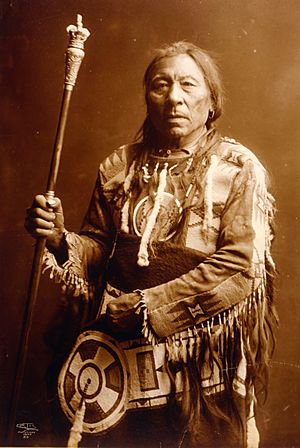Aatsista-Mahkan facts for kids
Quick facts for kids
Running Rabbit
|
|
|---|---|
| Aatsista-Mahkan | |

Chief Running Rabbit photographed by Edward S. Curtis, c. 1900
|
|
| Born | c. 1833 |
| Died | probably 24 January 1911 |
| Nationality | Siksika (Blackfoot) Blackfoot Confederacy |
| Known for | A chief of the Siksika people |
| Parent(s) | Many Swans (father) |
| Relatives | Many Swans II (brother) |
Aatsista-Mahkan, also known as Running Rabbit (c. 1833 – probably 24 January 1911), was an important chief of the Siksika First Nation. He was the son of Akamukai (Many Swans), who was also a chief. After his father passed away in 1871, Running Rabbit became the leader of his band. He was well-known for being very generous and kind. People also admired him for always protecting his family.
In 1877, he signed Treaty 7 with the Canadian government. This treaty changed how his people lived. Even after signing, he and his people continued to hunt bison until 1881. At that time, they moved to a special area called a reserve. This reserve was about 60 miles east of where Calgary, Alberta is today.
Contents
Early Life and First Successes
Running Rabbit grew up in a well-known family. His older brother, also named Many Swans, was the chief of their Siksika band, called the Biters. As a young man, Running Rabbit had not yet done anything famous. But his brother lent him a special charm. This charm was made from a mirror decorated with eagle feathers and other items.
Running Rabbit used this charm on his first raid as a warrior. He was very successful, capturing two enemy horses. He gave these horses to his brother. After more successful trips, his brother gave him the charm as a gift. News of Running Rabbit's bravery spread. Many people in the Biters band started calling him the "young chief" even before he officially became a leader.
Becoming a Chief
In the autumn of 1871, Running Rabbit's brother, Chief Many Swans, died. Running Rabbit then became the chief of the Biters band. During his time as chief, he was known for being very kind, generous, and smart.
When Running Rabbit was among his band, his men were invited to eat, smoke, tell stories every day. He was generous. He gave his running horses out during hunts. Running Rabbit had four wives; two put up Sun Dances. He was kind to children and women.
Because he was so intelligent and kind, Running Rabbit often helped solve problems. People would ask him to settle arguments within his band and even the larger Siksika Nation. For example, in the early 1870s, an accident happened near the Oldman River. A man from Running Rabbit's band accidentally harmed one of Crowfoot's daughters. Crowfoot was a very important chief. The man hid in Running Rabbit's teepee. Running Rabbit explained to Crowfoot that it was an accident. He also offered Crowfoot some horses to make up for it.
Running Rabbit usually solved problems peacefully. However, he would act strongly if his family was in danger. In one case, he protected his blind brother when he was being mistreated.
Signing Treaty No. 7
Running Rabbit signed Treaty 7 with the Canadian government. Other Siksika chiefs, like Crowfoot and Old Sun, also signed it. This treaty promised the Blackfoot Confederacy certain things. They would receive reserve lands, hunting rights, and yearly payments from the Queen. In return, they gave up most of their traditional lands.
Running Rabbit was seen as a minor Siksika chief at the time. He was listed as having about 90 followers. He and his band continued their traditional way of life, following the bison. But by 1881, most of the bison herds were gone. This meant his band and others had to settle on their reserve. This reserve was 60 miles east of Calgary, Alberta. On the reserve, Running Rabbit worked hard to adapt to this new lifestyle. By 1887, he was known as a successful farmer.
Later Life and Legacy
In 1892, after the head chief No-okska-stumik (Three Bulls) died, Running Rabbit became one of the two head chiefs of the Siksika Nation. The other head chief was Old Sun. Running Rabbit continued to be respected for his wisdom, kindness, and willingness to try new things. For example, in 1898, he earned enough money from harvesting hay to buy a modern buggy. Running Rabbit passed away in 1911.
See Also
- List of Siksika Nation people


